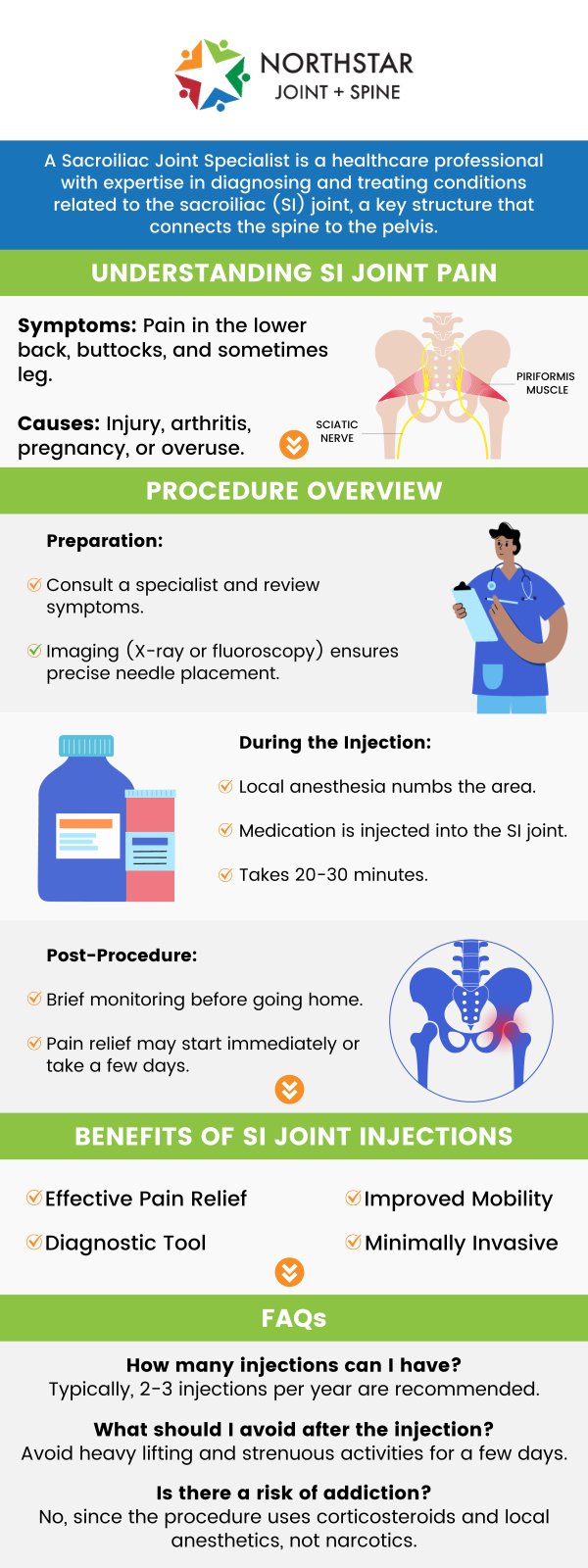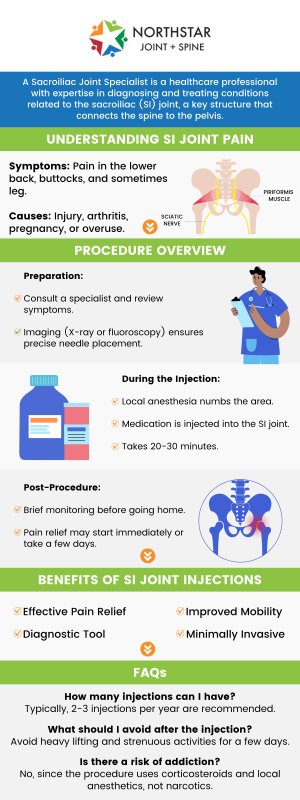What Is Sacroiliitis?
Sacroiliitis occurs when the sacroiliac joints, which connect the lower spine to the pelvis, become inflamed. This inflammation can lead to persistent pain in the lower back, hips, or buttocks, often making it difficult to perform daily activities. It is commonly associated with conditions like arthritis or infections. At Northstar Joint and Spine, Dr. Robert J. Nocerini provides tailored treatments to address sacroiliitis, helping you achieve relief and regain functional movement. For more information, contact us today or schedule an appointment. We are conveniently located at 7704 San Jacinto Pl Suite #200 Plano, TX 75024.


Table of Contents:
How long does sacroiliitis last?
What treatments are available for sacroiliitis?
What are the complications of sacroiliitis?
What are the stages of sacroiliitis?
How long sacroiliitis lasts is capable of varying and it often depends on the underlying cause and how the condition is managed once symptoms begin. In some cases, inflammation of the sacroiliac joints may resolve within a period of a few weeks, particularly when triggered by overuse. For others, especially when tied to a systemic inflammatory condition, symptoms can persist for longer or flare up intermittently over the course of months or years. The discomfort may shift in intensity, with periods of relative calm followed by renewed stiffness or pain, especially after prolonged inactivity.
Some patients find that with consistent care, including rest, physical therapy, and specialized treatment, the worst bouts of inflammation can be brought under control over time. When the source is chronic, the focus tends to shift from quick resolution to long-term symptom management. The specialists at Northstar Joint and Spine treat sacroiliitis with individualized treatment built around both the patient’s daily activity level and the source of the inflammation.
A range of treatment options exists for sacroiliitis, depending on what’s driving the inflammation and how severely it’s affecting mobility and quality of life. Anti-inflammatory medications are typically the first line of defense, aiming to reduce swelling and alleviate pain. Some patients benefit from physical therapy that helps to stabilize the surrounding muscles, improve joint function, and ease the pressure placed on the sacroiliac area during daily movements. Rest and posture modifications also play a role in recovery, especially for those whose symptoms are aggravated by long periods of sitting or standing. When these initial measures aren’t enough, more targeted treatments may be utilized. Corticosteroid injections directly into the sacroiliac joint can help dial down the inflammation for a longer period, particularly in more stubborn cases. In some situations, image-guided procedures may be used to ensure precision. The team at Northstar Joint and Spine draws from a range of interventional techniques designed to keep the condition from leading to long-term issues and help to avoid further aggravation.
If sacroiliitis is left unaddressed or poorly managed, it can evolve into a more persistent source of pain that interferes with daily function. One of the more common complications is the development of chronic lower back or hip discomfort, particularly during activities that involve bending, lifting, or twisting. Over time, the surrounding muscles may begin to compensate in ways that throw off alignment or trigger strain in nearby joints. This kind of secondary tension can create a ripple effect through the spine, hips, or even knees.
In cases where sacroiliitis is associated with inflammatory arthritis, the joint may experience progressive damage. This can lead to stiffness, reduced mobility, and, in certain circumstances, fusion of the sacroiliac joint. While this doesn’t happen in every case, ongoing inflammation does raise the risk of structural changes that become more difficult to reverse. Early diagnosis and treatment at Northstar Joint and Spine often make the biggest difference in limiting these longer-term effects and helping patients preserve their range of motion and quality of life.
The presentation of sacroiliitis stages can fluctuate according to individual circumstances, but it often progresses in certain ways if the inflammation isn’t managed early on. In the initial phase, symptoms may come and go, typically triggered by physical stress, prolonged sitting, or standing for too long. As inflammation builds, pain can become more localized around the hips or buttocks, sometimes radiating down the legs, especially when one or both joints become increasingly involved.
If left untreated, the condition may worsen to a state where pain becomes a regular occurrence in the patient’s daily life. Stiffness in the morning or after periods of rest may last longer, and some patients begin to notice reduced mobility or difficulty bearing weight evenly across the pelvis. Imaging at this point may show changes in the joint’s structure. The team at Northstar Joint and Spine focuses on identifying sacroiliitis in its earlier stages, where inflammation can often be brought under control before the joint endures any long-term damage.
Sacroiliitis treatment is available at Northstar Joint and Spine. For more information, contact us today or schedule an appointment. We are conveniently located at 7704 San Jacinto Pl Suite #200 Plano, TX 75024. We serve patients from Plano TX, Willow Bend TX, Frisco TX, Allen TX, Addison TX, North Dallas TX, and surrounding areas.

Additional Services You May Need
▸ Back Pain
▸ Chronic Pain
▸ Epidural Steroid Injections
▸ Spinal Cord Stimulation
▸ Viscosupplementation
▸ Genicular Nerve Blocks
▸ Facet Injections
▸ Joint Injections
▸ Sacroiliac Joint Injections
▸ Lumbar and Cervical
▸ Facet Medial Branch Blocks
▸ Diagnostic Nerve Blocks
▸ Medication Management
▸ Neck Pain Doctor
▸ Diabetic Peripheral Neuropathy
▸ Headaches
▸ Suboxone
▸ Botox for Migraines
▸ Peripheral Nerve Stimulation

Additional Services You May Need
▸ Back Pain
▸ Chronic Pain
▸ Epidural Steroid Injections
▸ Spinal Cord Stimulation
▸ Viscosupplementation
▸ Genicular Nerve Blocks
▸ Facet Injections
▸ Joint Injections
▸ Sacroiliac Joint Injections
▸ Lumbar and Cervical
▸ Facet Medial Branch Blocks
▸ Diagnostic Nerve Blocks
▸ Medication Management
▸ Neck Pain Doctor
▸ Diabetic Peripheral Neuropathy
▸ Headaches
▸ Suboxone
▸ Botox for Migraines
▸ Peripheral Nerve Stimulation






